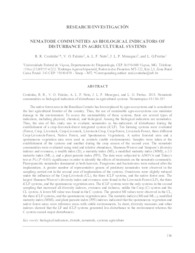Nematode communities as biological indicators of disturbance in agricultural systems.
Nematode communities as biological indicators of disturbance in agricultural systems.
Author(s): COUTINHO, R. R.; FALEIRO, V. de O.; FARIAS NETO, A. L. de; MENEGUCI, J. L. P.; FREITAS, L. G.
Summary: The native forest area in the Brazilian Cerrado has been replaced by agro-ecosystems and is considered the last agricultural frontier of the country. Thus, the use of sustainable agro-ecosystems can minimize damage to the environment. To assess the sustainability of these systems, there are several types of indicators, including physical, chemical, and biological. Among the biological indicators are nematodes. Thus, the aim of this study was to evaluate nematodes as bio-indicators of disturbance during the establishment of a crop-livestock-forest integrated system (iCLF). Ten farming systems were evaluated (Forest, Crop, Livestock, Crop-Livestock, Livestock-Crop, Crop-Forest, Livestock-Forest, three different Crop-Livestock-Forest, Native Forest, and Spontaneous Vegetation). A native forested area and a spontaneous vegetation area were used as controls (stable environments). Samples were taken at the establishment of the systems and another during the crop season of the second year. The nematode communities were evaluated using total and relative abundance, Shannon-Weaver and Simpson?s diversity indexes and evenness, a wealth index (D), a maturity index (MI), a modified maturity index (MMI), a 2-5 maturity index (MI2-5), and a plant parasite index (PPI). The data were subjected to ANOVA and Tukey's test at 5% (P <0.05) significance in order to identify the effects of treatments on the nematode community. Plant-parasitic nematodes dominated at both harvests. Fungivores and bacterivores were reduced after the implantation. A greater number of representative genera of predatory nematodes were observed in the sampling carried out in the second year of implantation of the systems. Omnivores were slightly reduced under the influence of the Crop-Livestock (CL), the three iCLF systems, and the native forest area. The largest Shannon-Weaver?s diversity index and evenness were found in the Livestock-Forest (LF), the three iCLF systems, and the spontaneous vegetation area. The iCLF systems were the only systems in the second sampling that increased all diversity indexes, evenness and richness, unlike the Crop (C) system and the CL system. A lower MI value was found in the C system. The greatest MI values were observed in the CL, the three iCLF systems, and the spontaneous vegetation area. The maturity indices (MI and MI2-5), modified maturity index (MMI), and plant parasite index (PPI) indexes indicated that the spontaneous vegetation and native forest areas were reference areas with stable environments. In short, diversity measures and other indexes showed that the LF and iCLF systems generated less disturbance to the environment whereas the C system caused major disturbances.
Publication year: 2018
Types of publication: Journal article
Keywords: Disturbed soils, Nematóide
Observation
Some of Embrapa's publications are published as ePub files. To read them, use or download one of the following free software options to your computer or mobile device. Android: Google Play Books; IOS: iBooks; Windows and Linux: Calibre.
Access other publications
Access the Agricultural Research Database (BDPA) to consult Embrapa's full library collection and records.
Visit Embrapa Bookstore to purchase books and other publications sold by Embrapa.

